Harman-Kardon AVR 145 User Manual

Designed to Entertain.TM
AVR 145
AUDIO/VIDEO RECEIVER OWNER’S MANUAL

TABLE OF CONTENTS
3 SAFETY INFORMATION
5 INTRODUCTION
7 FRONT-PANEL CONTROLS
9 REAR-PANEL CONNECTIONS
11 REMOTE CONTROL FUNCTIONS
14INTRODUCTION TO HOME THEATER
15CONNECTIONS
15 Speaker Connections
15 Subwoofer
15Connecting Source Devices to the AVR
16Audio Connections
16 |
Digital Audio |
16 |
Analog Audio |
16Video Connections
17Antennas
17RS-232 Serial Port
18SPEAKER PLACEMENT
19INSTALLATION
19 Step One – Connect the Speakers
19 Step Two – Connect the Subwoofer
19 Step Three – Connect the Antennas
19 Step Four – Connect the Source Components
22Step Five – Connect Video Display
22Step Six – Plug in AC Power
22Step Seven – Insert Batteries in Remote
23Step Eight – Program Sources Into the Remote
24Step Nine – Turn On the AVR 145
25INITIAL SETUP
25Using the On-Screen Menu System
25Step One – Determine Speaker Size
26Step Two – Measure Speaker Distances
26Step Three – Manual Setup Menu
26Speaker Size Menu
27Speaker Crossover Menu
28Delay Adjust Menu
28Step Four – EzSet Output Level Calibration
29Step Five – Configure Sources
31 OPERATION
31Turning On the AVR 145
31Sleep Timer
31Volume Control
32Mute Function
32 Tone Controls
32 Headphones
32Source Selection
33Audio Input Selection
33Video Input Selection
336-Channel Direct Inputs
33Using the Tuner
34Recording
34Using TheBridgeTM
35Selecting a Surround Mode
36ADVANCED FUNCTIONS
36Audio Processing and Surround Sound
36 |
Analog Audio Signals |
36Digital Audio Signals
37Surround Modes
38Dolby Surround Settings
38 |
Default Modes |
41Setting Channel Output Levels Manually
42System Settings
43Dim Function
43 |
Advanced Remote Control Functions |
43 |
Punch-Through Programming |
43Macros
44Resetting the Remote
44Processor Reset
44Memory
45TROUBLESHOOTING GUIDE
46TECHNICAL SPECIFICATIONS
46Trademark Acknowledgements
47APPENDIX
WARNING
To prevent fire or shock hazard, do not expose this appliance to rain or moisture.
For Canadian model
This class B digital apparatus complies with Canadian ICES-003.
For models having a power cord with a polarized plug: CAUTION: To prevent electric shock, match wide blade of plug to wide slot, fully insert.
Modèle pour les Canadien
Cet appareil numérique de la classe B est conforme à la norme NMB-003 du Canada.
Sur les modèles dont la fiche est polarisee: ATTENTION: Pour éviter les chocs électriques, introduire la lame la plus large de la fiche dans la borne correspondante de la prise et pousser jusqu’au fond.
2
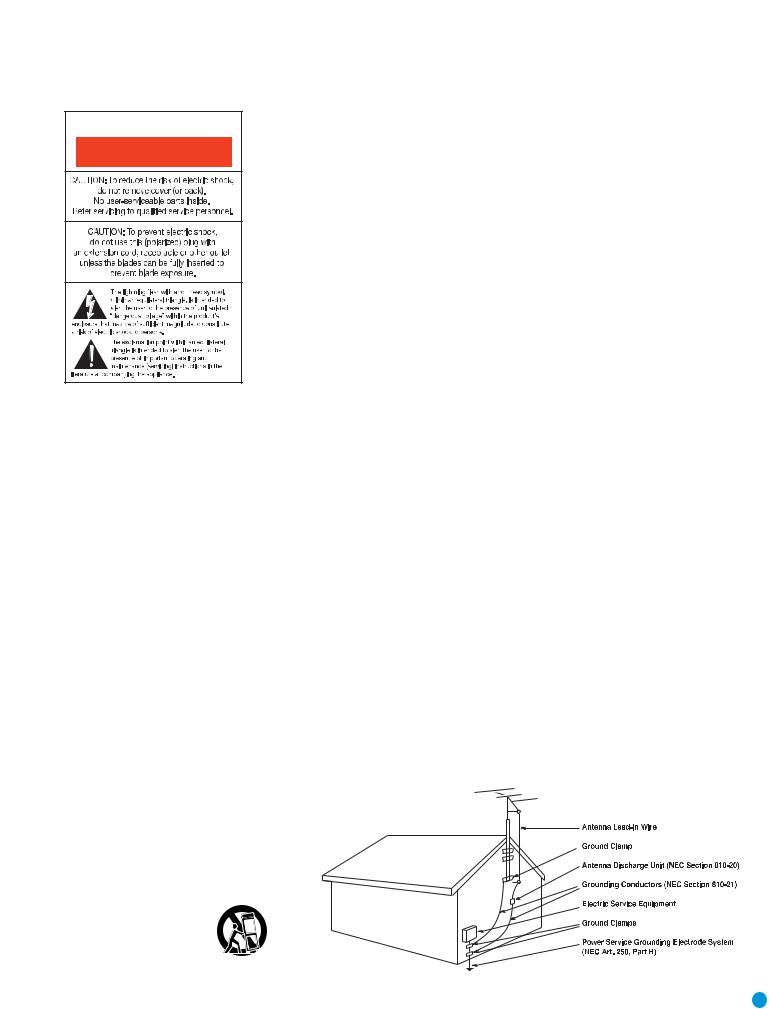
SAFETY INFORMATION
CAUTION
RISK OF ELECTRIC SHOCK
DO NOT OPEN
1.Read these instructions.
2.Keep these instructions.
3.Heed all warnings.
4.Follow all instructions.
5.Do not use this apparatus near water.
6.Clean only with a dry cloth.
7.Do not block any ventilation openings. Install in accordance with the manufacturer’s instructions.
8.Do not install near any heat sources such as radiators, heat registers, stoves or other apparatus (including amplifiers) that produce heat.
9.Do not defeat the safety purpose of the polarized or grounding-type plug. A polarized plug has two blades with one wider than the other. A grounding-type plug has two blades and a third grounding prong. The wide blade or the third
prong are provided for your safety. If the provided plug does not fit into your outlet, consult an electrician for replacement of the obsolete outlet.
10.Protect the power cord from being walked on or pinched, particularly at plugs, convenience receptacles and the point where they exit from the apparatus.
11.Only use attachments/accessories specified by the manufacturer.
12.Use only with the cart, stand, tripod, bracket or table specified by the manufacturer or sold with the apparatus. When a cart is used, use caution when moving the cart/apparatus combination to avoid injury from tip-over.
13.Unplug this apparatus during lightning storms or when unused for long periods of
time.
14. Refer all servicing to qualified service personnel. Servicing is required when the apparatus has been
damaged in any way, such as power-supply cord or plug is damaged, liquid has been spilled or objects have fallen into the apparatus, the apparatus has been exposed to rain or moisture, does not operate normally, or has been dropped.
15.Do not use attachments not recommended by the product manufacturer, as they may cause hazards.
16.This product should be operated only from the type of power source indicated on the marking label. If you are not sure of the type of power supply to your home, consult your product dealer or local power company. For products intended to operate from battery power, or other sources, refer to the operating instructions.
17.If an outside antenna or cable system is connected to the product, be sure the antenna or cable system is grounded so as to provide some protection against voltage surges and built-up static charges. Article 810 of the National Electrical Code, ANSI/NFPA 70, provides information with regard to proper grounding of the mast and supporting structure, grounding of the lead-in wire to an antenna discharge unit, size of grounding conductors, location of antenna-dis- charge unit, connection to grounding electrodes, and requirements for the grounding electrode. See Figure A.
18.An outside antenna system should not be located in the vicinity of overhead power lines or other electric light or power circuits, or where it can fall into such power lines or circuits. When installing an outside antenna system, extreme care should be taken to keep from touching such power lines or circuits, as contact with them might be fatal.
19.Do not overload wall outlets, extension cords, or integral convenience receptacles, as this can result in a risk of fire or electric shock.
20.Never push objects of any kind into this product through openings, as they may touch
Figure A.
Example of Antenna Grounding as per
National Electrical Code ANSI/NFPA 70
dangerous voltage points or short-out parts that could result in a fire or electric shock. Never spill liquid of any kind on the product.
21.The apparatus shall not be exposed to dripping or splashing, and no objects filled with liquids, such as vases, shall be placed on the apparatus.
22.Do not attempt to service this product yourself, as opening or removing covers may expose you to dangerous voltage or other hazards. Refer all servicing to qualified service personnel.
23.When replacement parts are required, be sure the service technician has used replacement parts specified by the manufacturer or that have the same characteristics as the original part. Unauthorized substitutions may result in fire, electric shock or other hazards.
24.Upon completion of any service or repairs to this product, ask the service technician to perform safety checks to determine that the product is in proper operating condition.
25.The product should be mounted to a wall
or ceiling only as recommended by the manufacturer.
3

SAFETY INFORMATION
Important Safety Information
Verify Line Voltage Before Use
Your AVR 145 has been designed for use with 120-volt AC current. Connection to a line voltage other than that for which it is intended can create a safety and fire hazard and may damage the unit.
If you have any questions about the voltage requirements for your specific model, or about the line voltage in your area, contact your selling dealer before plugging the unit into a wall outlet.
unit’s feet may leave marks on certain wood or veneer materials. Use caution when placing the unit on soft woods or other materials that may be damaged by heat or heavy objects. Some surface finishes may be particularly sensitive to absorbing such marks, due to a variety of factors beyond Harman Kardon's control, including the nature of the finish, cleaning materials used, and normal heat and vibration caused by the use of the product, or other factors. We recommend that caution be exercised in choosing an installation location for the component and in normal maintenance practices, as your warranty will not cover this type of damage to furniture.
Do Not Use Extension Cords
To avoid safety hazards, use only the power cord attached to your unit. We do not recommend that extension cords be used with this product. As with all electrical devices, do not run power cords under rugs or carpets or place heavy objects on them. Damaged power cords should be replaced immediately by an authorized service center with a cord meeting factory specifications.
Handle the AC Power Cord Gently
When disconnecting the power cord from an AC outlet, always pull the plug; never pull the cord. If you do not intend to use the unit for any considerable length of time, disconnect the plug from the AC outlet.
Do Not Open the Cabinet
There are no user-serviceable components inside this product. Opening the cabinet may present a shock hazard, and any modification to the product will void your guarantee. If water or any metal object such as a paper clip, wire or staple accidentally falls inside the unit, disconnect it from the AC power source immediately, and consult an authorized service center.
CATV or Antenna Grounding
If an outside antenna or cable system is connected to this product, be certain that it is grounded so as to provide some protection against voltage surges and static charges. Section 810 of the National Electrical Code, ANSI/NFPA No. 70-1984, provides information with respect to proper grounding of the mast and supporting structure, grounding of the lead-in wire to an antenna discharge unit, size of grounding conductors, location of antenna discharge unit, connection to grounding electrodes and requirements of the grounding electrode.
NOTE TO CATV SYSTEM INSTALLER: This reminder is provided to call the CATV (cable TV) system installer’s attention to article 820-40 of the NEC, which provides guidelines for proper grounding and, in particular, specifies that the cable ground shall be connected to the grounding system of the building, as close to the point of cable entry as possible.
Installation Location
•To ensure proper operation and to avoid the potential for safety hazards, place the unit on a firm and level surface. When placing the unit on a shelf, be certain that the shelf and any mounting hardware can support the weight of the product.
•Make certain that proper space is provided both above and below the unit for ventilation. If this product will be installed in a cabinet or other enclosed area, make certain that there is sufficient air movement within the cabinet. Under some circumstances, a fan may be required.
•Do not place the unit directly on a carpeted surface.
•Avoid installation in extremely hot or cold locations, or in an area that is exposed to direct sunlight or heating equipment.
•Avoid moist or humid locations.
•Do not obstruct the ventilation slots on the top of the unit, or place objects directly over them.
•Due to the weight of the AVR 145 and the heat generated by the amplifiers, there is the remote possibility that the rubber padding on the bottom of the
4
Cleaning
When the unit gets dirty, wipe it with a clean, soft, dry cloth. If necessary, and only after unplugging the AC power cord, wipe it with a soft cloth dampened with mild soapy water, then a fresh cloth with clean water. Wipe it dry immediately with a dry cloth. NEVER use benzene, aerosol cleaners, thinner, alcohol or any other volatile cleaning agent. Do not use abrasive cleaners, as they may damage the finish of metal parts. Avoid spraying insecticide near the unit.
Moving the Unit
Before moving the unit, be certain to disconnect any interconnection cords with other components, and make certain that you disconnect the unit from the AC outlet.
Important Information for the User
This equipment has been tested and found to comply with the limits for a Class-B digital device, pursuant to Part 15 of the FCC Rules. The limits are designed to provide reasonable protection against harmful interference in a residential installation. This equipment generates, uses and can radiate radio-frequency energy and, if not installed and used in accordance with the instructions, may cause harmful interference to radio communication. However, there is no guarantee that harmful interference will not occur in a particular installation. If this equipment does cause harmful interference to radio or television reception, which can be determined by turning the equipment off and on, the user is encouraged to try to correct the interference by one or more of the following measures:
•Reorient or relocate the receiving antenna.
•Increase the separation between the equipment and receiver.
•Connect the equipment into an outlet on a circuit different from that to which the receiver is connected.
•Consult the dealer or an experienced radio/TV technician for help.
This device complies with Part 15 of the FCC Rules. Operation is subject to the following two conditions: (1) this device may not cause harmful interference, and (2) this device must accept interference received, including interference that may cause undesired operation.
NOTE: Changes or modifications may cause this unit to fail to comply with Part 15 of the FCC Rules and may void the user’s authority to operate the equipment.
Unpacking
The carton and shipping materials used to protect your new receiver during shipment were specially designed to cushion it from shock and vibration. We suggest that you save the carton and packing materials for use in shipping if you move, or should the unit ever need repair.
To minimize the size of the carton in storage, you may wish to flatten it. This is done by carefully slitting the tape seams on the bottom and collapsing the carton. Other cardboard inserts may be stored in the same manner. Packing materials that cannot be collapsed should be saved along with the carton in a plastic bag.
If you do not wish to save the packaging materials, please note that the carton and other sections of the shipping protection are recyclable. Please respect the environment and discard those materials at a local recycling center.
It is important that you remove the protective plastic film from the front-panel lens. Leaving the film in place will affect the performance of your remote control.

INTRODUCTION
Please register your product on our Web site at www.harmankardon.com.
Note: You’ll need the product’s serial number. At the same time, you can choose to be notified about our new products and/or special promotions.
WWW.HARMANKARDON.COM
Thank you for choosing Harman Kardon®!
In the years since Harman Kardon invented the high-fidelity receiver, we have taken to heart the philosophy of bringing the joy of home entertainment to as many people as possible, adding performance and ease-of- use features that enhance the home entertainment experience. In the years since our first single-channel component was introduced, Harman Kardon has offered a number of receiver models, each an improvement upon its predecessors, leading to the AVR 145, a 5.1-channel digital audio/video receiver that offers a wealth of listening and viewing options, all in an elegant package.
AVR 145 5.1-Channel Audio/Video Receiver
Audio Section
•40 watts x 5, five channels driven at full power at 8 ohms,
20Hz – 20kHz, <0.07% THD, (surround modes). 200 Watts total.
•50 watts x 2, two channels driven at full power at 8 ohms,
20Hz – 20kHz, <0.07% THD, (surround off mode). 100 Watts total.
•High current capability, ultrawide bandwidth amplifier design with low negative feedback
•All-discrete amplifier circuitry
•Dual independent power supplies, for front and surround channels
•Triple crossover bass management
•24-Bit, twin-core Cirrus Logic® CS 49510 DSP processor with 32-bit post processor
•192kHz/24-bit D/A conversion
•Sampling upconversion to 96kHz
To obtain the maximum enjoyment from your new receiver, we urge you to read this manual and refer back to it as you become more familiar with its features and their operation.
If you have any questions about this product, its installation or its operation, please contact your retailer or customer installer, or visit our Web site at www.harmankardon.com.
Surround Modes
•Dolby® Digital
•Dolby Pro Logic® II (Movie, Music and Game)
•Dolby Virtual Speaker Version 2 (Reference 2- or 3-speaker; Wide 2-, 3-, 4- or 5-speaker)
•Dolby Headphone Version 2
•DTS® (5.1; DTS Stereo)
•DTS 96/24™ (DTS Stereo)
•DTS Neo:6® (Cinema 3- or 5-channel; Music 5-channel)
•Logic 7® (Cinema, Music and Enhance)
•Hall 1 and Hall 2
•Theater
•5-Channel Stereo
•Surround Off (DSP or Analog Bypass)
5

INTRODUCTION
Audio Inputs
•AM/FM tuner
•CD
•Tape
•6-Channel direct
•TheBridgeTM /DMP for iPod®* connectivity
Audio/Video Inputs (With S-Video)
•Video 1
•Video 2
•Video 3
•DVD
•Two 100MHz assignable component video inputs
Digital Audio Inputs
•Two rear-panel/one front-panel coaxial
•Two rear-panel/one front-panel optical
Outputs
•Subwoofer output
•Tape (analog audio)
•Video 1 (analog audio and video)
•Video Monitor (composite, S-video and component)
•One coaxial, one optical (digital audio)
•Headphone
Ease of Use
•EzSet™ automated setup (microphone integrated into remote)
•On-screen display with composite and S-video; choice of blue or black background
•Two-line dot-matrix front-panel display
•Color-coded connections
•Programmable eight-device main remote control
•Source input renaming
•A/V Sync Delay
•RS-232 serial port for system upgrades
•Switched accessory power outlet
Supplied Accessories
The following accessory items are supplied with the AVR 145. If any of these items are missing, please contact Harman Kardon customer service at www.harmankardon.com.
•System remote control
•AM loop antenna
•FM wire antenna
•Three AAA batteries
•Two covers for front-panel jacks
*Compatible with all iPod models equipped with a dock connector. Not compatible with iPod shuffle™ models. Although iPod photo and video models are compatible, images and videos stored on the iPod may not be viewed.
6

FRONT-PANEL CONTROLS
Main Power Switch: This is a mechanical switch that turns the power supply on or off. It is usually left pressed in (On position) at all times, and cannot be turned on using the remote control.
Standby/On Switch: This is an electrical switch that turns the receiver on for playback, or leaves it in standby mode for quick turn-on using this switch or the remote control.
Power Indicator: This LED has three possible modes. When main power is turned off, the LED is dark and the receiver won’t respond to any button presses. When main power is turned on, but before the Standby/On Switch is used, the LED turns amber and the receiver is ready to be turned on. When the receiver is turned on, the LED
turns blue.
Source Select: Press this button to select a source device, which is a component where a playback signal originates, e.g. DVD, CD, cable TV, satellite or HDTV tuner.
Source Indicators: The name of the current source input lights up. The indicated input changes each time the Source Select button is pressed.
Volume Knob: Turn this knob to raise or lower the volume, which will be shown in decibels (dB) in the Message Display.
Message Display: Various messages appear in this two-line display in response to commands. When the on-screen display menu system (OSD) is in use, the message OSD ON will appear to remind you to check the video display.
Tuner Band: Press this button to select the tuner as the source, or to switch between the AM and FM bands.
Tuning: Press either side of this button to tune a radio station.
Tuning Mode: This button toggles between manual (one frequency step at a time) and automatic (seeks frequencies with acceptable signal strength) tuning mode. It also toggles between stereo and mono modes when an FM station is tuned.
Preset Stations: Press this button to select a preset radio station.
Headphone Jack: Plug a 1/4" headphone plug into this jack for private listening.
Surround Mode: Press this button to select a type of surround sound (e.g. multichannel) mode. Choose from the Dolby modes, DTS modes, Logic 7 modes, DSP modes or Stereo modes.
Surround Select: After you have selected the desired type of surround mode, press this button to select a specific variant of that type of mode.
Surround Mode Indicators: One or more of these icons may light up as you select different surround modes. The Message Display also indicates the surround mode.
Analog Audio, Video and Digital Audio Inputs: Connect a source component that will only be used temporarily to these jacks, such as a camera or game console. Remember to select only one type of audio and one type of video connection.
Speaker/Channel Input Indicators: The box icons indicate which speaker positions you have configured, and the size (frequency range) of each speaker. When a digital audio input is used, letters will light inside the boxes to indicate which channels are present in the incoming signal.
Navigation: These buttons are used together with the following five buttons to make selections.
Tone Mode: Press this button to access the tone controls (bass and treble). Use the ‹/› Navigation buttons to make your selections.
Speaker: Press this button to configure speaker sizes, that is, the fre- quency-range capability of each speaker.
Channel Level Adjust: Press this button to set the output levels for each channel so that all speakers sound equally loud at the listening position.
Digital Input Select: Press this button to select the specific digital audio input (or analog audio input) you used for the current source.
Delay: Press this button to set delay times that compensate for placing the speakers at different distances from the listening position.
7
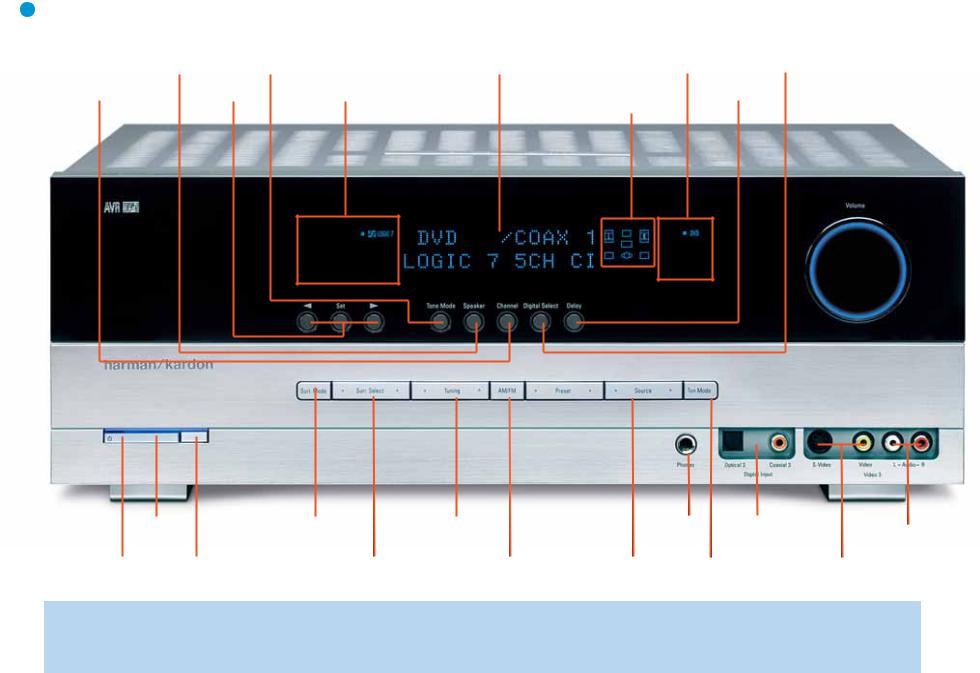
8
|
|
|
|
Message Display |
Source |
|
Digital Input |
|
|
||
|
Speaker Size |
Tone Mode |
Indicators |
|
Select |
|
|
||||
Channel Level |
Setup |
|
Surround Mode Indicators |
|
Speaker/Channel |
Delay |
Volume |
||||
Navigation |
|
||||||||||
Adjust |
|
|
|
|
Input Indicators |
|
|
|
|
|
|
|
|
|
|
|
|
|
|
|
|
||
|
|
|
|
|
|
|
|
|
|
|
|
|
|
|
|
|
|
|
|
|
|
|
|
|
|
|
|
|
|
|
|
|
|
|
|
|
|
|
|
|
|
|
|
|
|
|
|
|
|
|
|
|
|
|
|
|
|
|
|
Power |
|
Surround |
Tuning |
Preset Stations |
Headphone |
Digital |
Analog Audio |
Indicator |
Mode |
|
|
Jack |
Audio Inputs |
||
|
|
Inputs |
|||||
|
|
|
|
|
|
|
|
Standby/On |
Main Power |
Surround |
Tuner Band |
Source |
Tuning |
|
Video Inputs |
Switch |
Switch |
Select |
|
Select |
Mode |
|
|
NOTE: To make it easier to follow the instructions throughout the manual that refer to this illustration, a copy of this page may be downloaded from the Product Support section at www.harmankardon.com

REAR-PANEL CONNECTIONS
AM and FM Antenna Terminals: Connect the included AM and FM antennas to their respective terminals for radio reception.
Front, Center and Surround Speaker Outputs: Use two-con- ductor speaker wire to connect each set of terminals to the correct speaker. Remember to observe the correct polarity (positive and negative connections). Always connect the positive lead to the colored terminal on the receiver and the red terminal on the speaker. Connect the negative lead to the black terminal on both the receiver and the speaker. See the Connections section for more information on connecting your speakers.
Subwoofer Output: If you have a powered subwoofer, connect it to this jack.
Video 1, Video 2 and DVD Audio/Video Inputs: These jacks may be used to connect your video-capable source components (e.g., VCR, DVD player, cable TV box) to the receiver. Remember to use only one type of video connection for each source. See the Connections section for more information on audio and video connection options for each source component.
Video 1 Audio/Video Outputs: These jacks may be used to connect your VCR or another recorder.
Composite and S-Video Monitor Outputs: If some of your sources use composite or S-video connections, then you will need to connect one or both of these monitor outputs to the corresponding inputs on your television or video display in order to view the sources.
CD and Tape Audio Inputs: These jacks may be used to connect your audio-only source components (e.g., CD player, tape deck). Do not connect a turntable to these jacks unless you are using the turntable with a phono preamp.
Tape Outputs: These jacks may be used to connect your CDR or another audio-only recorder.
Coaxial and Optical Digital Audio Inputs: If your source has a compatible digital audio output, connect it to one of these jacks for improved audio performance. Remember to use only one type of digital audio connection for each source.
Coaxial and Optical Digital Audio Outputs: If your source is also an audio recorder, you may connect a compatible digital audio output to the recorder’s input for improved recording quality.
The Bridge/DMP Input: Connect the optional Harman Kardon TheBridgeTM to this input for use with your iPod (not included). Make
sure the receiver is turned off (in Standby mode) when connecting The Bridge.
6-Channel Inputs: Connect the analog audio outputs of a DVDAudio, SACD™, Blu-ray Disc™ or HD-DVD™ player (or any other external decoder) to these jacks to enjoy these proprietary formats.
Component Video Inputs: If both your video source (e.g., DVD player or HDTV tuner) and your television or video display have analog component video (Y/Pb/Pr) capability, then you may connect the component video outputs of your source to one of the two component video inputs. Do not make any other video connections to that source.
Component Video Monitor Outputs: If you are using one or both of the Component Video Inputs and your television or video display is component-video-capable, you may connect these jacks to the corresponding inputs on your video display. You will also need to connect the composite and/or S-video monitor outputs to your video display if some of your sources use those types of video connections.
RS-232 Serial Port: This specialized connector may be used with your personal computer in case Harman Kardon offers a software upgrade for the receiver at some time in the future.
RS-232 Mode: Leave this switch popped out in the Operate position unless the AVR 145 is being upgraded.
RS-232 Reset: This switch is only used during a software upgrade. A standard processor reset is performed by pressing and holding the front-panel Tone button.
Switched AC Accessory Outlet: You may plug the AC power cord of one source device into this outlet, and it will turn on whenever you turn on the receiver. Do not use a source that consumes more than 50 watts of power.
AC Power Cord: After you have made all other connections, plug the AC power cord into an unswitched outlet.
9
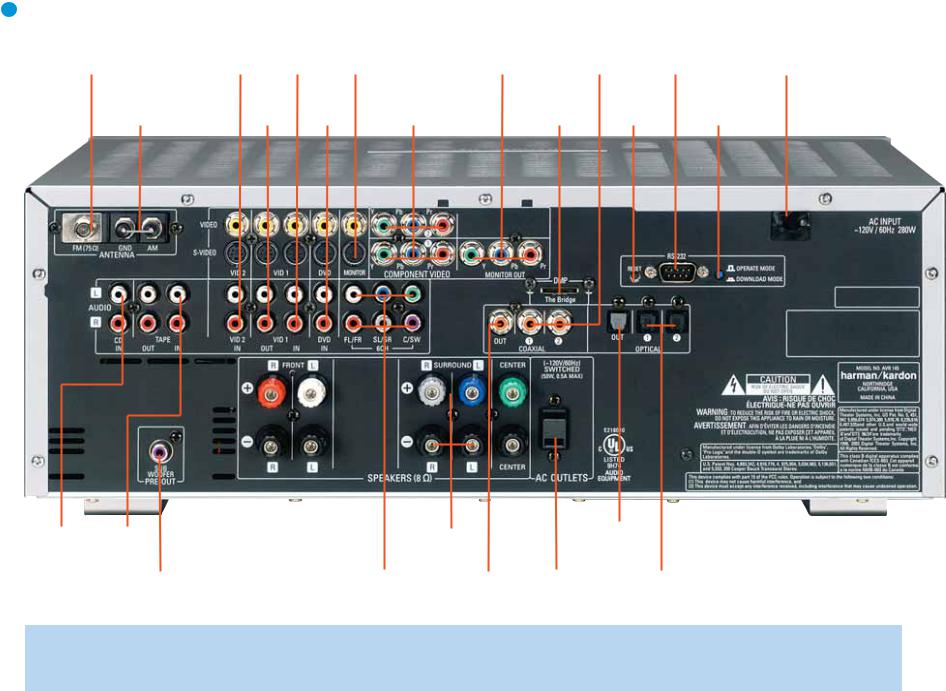
10
|
Video 2 |
Video 1 |
Video |
|
Coaxial Digital |
RS-232 |
AC Power |
|
A/V |
A/V |
Monitor |
Component Video |
|||
FM Antenna |
Inputs |
Inputs |
Outputs |
Monitor Outputs |
Audio Inputs |
Serial Port |
Cord |
|
|
|
|
|
(1 & 2) |
|
|
|
Video 1 |
|
|
|
|
|
|
A/V |
DVD A/V |
Component Video |
The Bridge/ |
RS-232 |
RS-232 |
AM Antenna |
Outputs |
Inputs |
Inputs (1 & 2) |
DMP Input |
Reset |
Mode |
|
|
|
|
|
|
|
|
|
|
|
|
|
|
|
|
|
|
|
|
|
|
|
|
|
|
|
|
|
|
|
|
|
|
|
|
|
|
|
|
|
|
|
|
|
|
|
|
|
|
|
|
|
|
|
|
|
|
|
|
CD |
Tape |
|
|
Front |
Surround |
Center |
Optical Digital |
||||
Inputs |
Inputs |
|
|
Speaker |
Speaker |
Speaker |
Audio Output |
||||
|
|
|
|
Outputs |
Outputs |
Outputs |
|
||||
|
|
|
|
|
|
|
|
|
|
|
|
Tape |
Subwoofer |
6-Channel |
Coaxial Digital |
Switched AC |
Optical Digital |
Outputs |
Output |
Inputs |
Audio Output |
Accessory |
Audio Inputs (1 & 2) |
|
|
|
|
Outlet |
|
NOTE: To make it easier to follow the instructions throughout the manual that refer to this illustration, a copy of this page may be downloaded from the Product Support section at www.harmankardon.com

REMOTE CONTROL FUNCTIONS
The AVR 145 remote is capable of controlling nine devices, including the AVR itself and an iPod docked in the optional The Bridge accessory. During the installation process, you may program the codes for each of your source components into the remote. Each time you wish to use the codes for any component, you will need to first press the Selector button for that component. This changes the button functions to the appropriate codes for that product.
Each Input Selector has been preprogrammed to control certain types of components, with only the codes specific to each brand and model changing, depending on which product code is programmed. The device types programmed into each selector may not be changed.
DVD: Controls DVD players and recorders.
CD: Controls CD players and recorders.
Tape: Controls cassette decks.
Video 1: Controls VCRs, TiVo and DVRs.
Video 2: Controls cable and satellite television set-top boxes.
Video 3: Controls televisions and other video displays.
The Bridge/DMP: Controls an iPod docked in The Bridge.
For example, if you have inserted a disc in your CD player and Iyou would like to skip ahead three tracks, but you then find that the volume is too loud, you would follow this procedure:
1.Press the CD Input Selector to switch to the codes that control your CD player.
2.Press the Play Button (in the Transport Controls section) if the disc is not already playing.
3.Press the Skip Up Button three times to advance three tracks.
4.Press the AVR Button so that you can access the Volume Controls.
5.Press the Volume Down Button until the volume level is satisfactory.
Any given button may have different functions, depending on which component is being controlled. Some buttons are labeled with these functions. For example, the Sleep and DSP Surround Buttons are labeled for use as Channel Up/Down Buttons when controlling a television or cable box. See Table A8 in the appendix for listings of the different functions for each type of component.
IR Transmitter Lens: As buttons are pressed on the remote, infrared codes are emitted through this lens. Make sure it is pointing toward the component being operated.
EzSet™ Microphone: This microphone “hears” the test tone used during the EzSet level-setting procedure. Make sure it is pointing toward the receiver when running EzSet.
Power On Button: Press this button to turn on the AVR or another device. The Master Power Switch on the AVR 145’s front panel must first have been switched on.
Mute Button: Press this button to mute the AVR 145’s speaker and headphones outputs temporarily. To end the muting, press this button or adjust the volume. Muting is also canceled when the receiver is turned off.
Program/EzSet Indicator: This LED lights up or flashes in one of three colors as the remote is programmed with codes, and during the EzSet procedure.
Power Off Button: Press this button to turn off the AVR 145 or another device.
AVR Selector: Press this button to switch the remote to the codes that operate the receiver.
Input Selectors: Press one of these buttons to select a source device, which is a component where a playback signal originates, e.g., DVD, CD, cable TV, satellite or HDTV tuner. This will also turn on the receiver and switch the remote to the codes that operate the source device.
AM/FM Button: Press this button to select the tuner as the source, or to switch between the AM and FM bands.
6-Channel Input Selector: Press this button to select the 6- Channel Inputs as the audio source. The receiver will use the video input and remote control codes for the last-selected video source.
EzSet (SPL) Button: Press this button to run the EzSet output-level calibration procedure. Make sure to point the remote toward the receiver during EzSet.
The Bridge/DMP Selector: Press this button to select an iPod docked in the optional The Bridge as the audio source. The remote will switch to the codes that operate the iPod.
Test Tone: Press this button to activate the test tone for manual out- put-level calibration.
TV/Video: This button has no effect on the receiver, but is used to switch video inputs on some video source components.
Sleep Button: Press this button to activate the sleep timer, which shuts off the receiver after a programmed period of time of up to 90 minutes.
Volume Controls: Press these buttons to raise or lower the volume, which will be shown in decibels (dB) in the Message Display.
DSP Surround: Press this button to select a DSP surround mode (Hall 1, Hall 2, Theater).
On-Screen Display (OSD): Press this button to activate the onscreen menu system.
Channel Level: Press this button to set the output levels for each channel so that all speakers sound equally loud at the listening position. Usually this is done while playing an audio selection, such as a favorite CD, after you have calibrated the levels using EzSet, as described in the Getting Started section.
11

IR Transmitter Lens
Power On
Program/EzSet Indicator
AVR Selector
AM/FM
EzSet (SPL)
Test Tone
Sleep
DSP Surround
On-Screen Display
Channel Level
Digital Input
Tuning Mode
Direct Station Entry
Tuning
Tone Mode
Night Mode
Track Skip
Transport Controls
EzSet Microphone
Mute
Power Off
Input Selectors
6-Channel Input Selector
TheBridgeTM /DMP Selector
TV/Video
Volume Control
Not Used
Speaker Setup
Set
Delay
Numeric Keys
Memory
Clear
Preset Stations Selectors
Disc Skip
Macros
Surround Mode Selectors
Dim
145
NOTE: To make it easier to follow the instructions throughout the manual that refer to this illustration, a copy of this page may be downloaded from the Product Support section at www.harmankardon.com
12

REMOTE CONTROL FUNCTIONS
Speaker Setup: Press this button to configure speaker sizes, that is, the frequency-range capability of each speaker. Usually this is done using the on-screen menu system, as described in the Getting Started section.
Navigation and Set Buttons: These buttons are used together to make selections within the on-screen menu system, or when accessing the functions of the four buttons surrounding this area of the remote – Channel Level, Speaker Setup, Digital Input or Delay.
Digital Input Select: Press this button to select the specific digital audio input (or analog audio input) you used for the current source.
Delay: Press this button to set delay times that compensate for placing the speakers at different distances from the listening position, or to resolve a “lip sync” issue that may be caused by digital video processing. This is done using the on-screen menu system, as described in the Initial Setup section.
Numeric Keys: Use these buttons to enter radio station frequencies when using the tuner (after pressing the Direct Button), or to select station presets.
Tuning Mode: This button toggles between manual (one frequency step at a time) and automatic (seeks frequencies with acceptable signal strength) tuning mode. It also toggles between stereo and mono modes when an FM station is tuned.
Memory: After you have tuned a particular radio station, press this button, then the numeric keys, to save that station as a radio preset.
Tuning: Press these buttons to tune a radio station. Depending on whether the tuning mode has been set to manual or automatic, each press will either change one frequency step at a time, or seek the next frequency with acceptable signal strength.
Direct: Press this button before using the Numeric Keys to directly enter a radio station frequency.
Clear: Press this button to clear a radio station frequency you have started to enter.
Preset Stations Selector: Press these buttons to select a preset radio station.
Tone Mode: Press this button to access the tone controls (bass and treble). Use the Navigation buttons to make your selections.
Disc Skip: This button has no effect on the receiver, but is used with some optical disc changers to skip to the next disc.
Macros: These buttons may be programmed to execute long command sequences with a single button press. They are useful for programming the command to turn on or off all of your components, or for accessing specialized functions for a different component than you are currently operating.
Surround Mode Selectors: Press any of these buttons to select a type of surround sound (e.g., multichannel) mode. Choose from the Dolby modes, DTS modes, Logic 7 modes or Stereo modes. Each press of a button will cycle to the next available variant of that mode. Not all modes or mode groups are available with all sources.
Night Mode: Press this button to activate Night mode with specially encoded Dolby Digital discs or broadcasts. Night mode compresses the audio so that louder passages are reduced in volume to avoid disturbing others, while dialogue remains intelligible.
Track Skip: These buttons have no effect on the receiver, but are used with many source components to change tracks or chapters.
Dim: Press this button to partially or fully dim the front-panel display.
Transport Controls: These buttons have no effect on the receiver, but are used to control many source components. By default, when the remote is operating the receiver, these buttons will control a DVD player.
13

INTRODUCTION TO HOME THEATER
The AVR 145 may be the first multichannel surround sound receiver you have owned. Although it has more connections and features than older two-channel receivers, many of the principles are similar and the new concepts are easy to understand. This introductory section will help you to familiarize yourself with the basic concepts, which will make setup and operation smoother.
If you are already familiar with home theater, you may skip this section and proceed to the Connections section on page 15.
Typical Home Theater System
A home theater typically includes your audio/video receiver, which controls the system; a DVD player; a source component for television broadcasts, which may be a cable box, a satellite dish receiver, an HDTV tuner or simply an antenna connected to the TV; a video display (television); and loudspeakers.
All of these components are connected by various types of cables for audio and video signals.
Multichannel Audio
The main benefit of a home theater system is that several loudspeakers are used in various locations around the room to produce “surround sound.” Surround sound helps to immerse you in the musical or film presentation for increased realism.
The AVR 145 may have up to five speakers connected directly to it (plus a subwoofer). Each speaker is powered by its own amplifier channel inside the receiver. When more than two speakers are used, it is called a multichannel system.
•Front Left and Right – The main speakers are used the same way as in a two-channel system. However, you may notice that in many surround modes, these speakers are used more for ambient sound while the main action is moved to the center speaker.
•Center – The center speaker is usually placed above or below the video screen, and is used mostly for dialogue in movies and television programs. This placement allows the dialogue to originate near the actors’ faces, for a more natural sound.
•Surround Left and Right – The surround speakers are used to improve directionality of ambient sounds. In addition, by using more loudspeakers in the system, more dynamic soundtracks may be played without risk of overloading any one speaker.
Many people expect the surround speakers to play as loudly as the front speakers. Although all of the speakers in the system will be calibrated to sound equally loud at the listening position, most artists use the surround speaker for ambient effects only, and they program their materials to steer very little sound to these speakers.
•Subwoofer – A subwoofer is a special-purpose speaker designed to play only the lowest frequencies (the bass). It may be used to augment smaller, limited-range satellite speakers used for the other channels. In addition, many digital-format programs, such as movies recorded in Dolby Digital, contain a special low-frequency effects
(LFE) channel which is directed only to the subwoofer. The LFE channel packs the punch of a rumbling train or airplane, or the power of an explosion, adding realism and excitement to your home theater. Many people use two subwoofers, placed on the left and right sides of the room, for additional power and even distribution of the sound.
Surround Modes
There are different theories as to the best way to present surround sound and to distribute soundtrack information among the various speakers. A variety of algorithms have been developed in an effort to accurately reproduce the way we hear sounds in the real world. The result is a rich variety of surround mode options. Some modes are selected automatically, depending on the signal being received from the source. In many cases, you may select a surround mode manually.
Several companies have taken surround sound in slightly differing directions. It is helpful to group the numerous surround modes either by their brand name, or by using a generic name:
•Dolby Laboratories, Inc. Modes – Dolby Digital, Dolby Pro Logic II, Dolby Virtual Speaker, Dolby Headphone
•DTS Modes – DTS, DTS Neo:6, DTS 96/24
•Harman International (Harman Kardon’s Parent Company) –
Logic 7
•DSP Modes – Generic modes that include Hall 1, Hall 2 and Theater
•Stereo Modes – Generic modes that expand upon conventional twochannel stereo, including DSP Surround Off, Analog Bypass Surround Off and 5-Channel Stereo
Table 4 on pages 38 – 40 contains detailed explanations of the differences between the various mode groups, and the mode options available within each group. Digital modes, such as Dolby Digital and DTS, are only available with specially encoded programs, such as DVDs and digital cable or satellite television. Other modes may be used with various digital and analog signals to create a different surround presentation, or to use a different number of speakers. Surround mode selection depends upon the number of speakers in your system, the materials you are watching or listening to, and your personal tastes. Feel free to experiment.
14
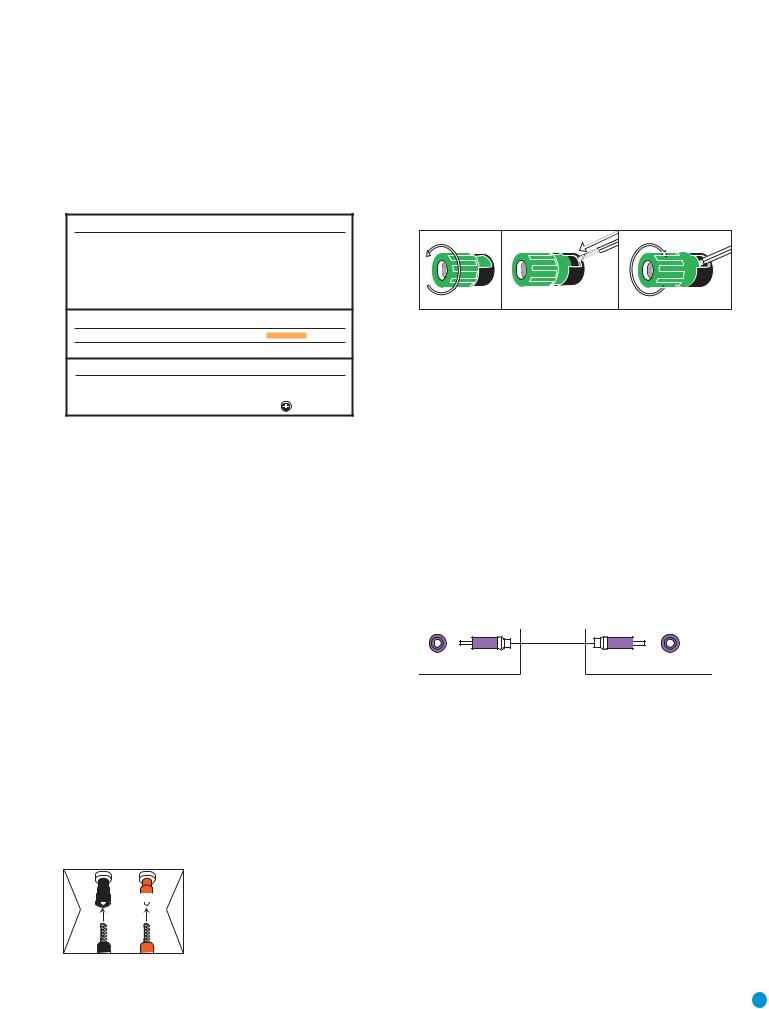
CONNECTIONS
There are different types of audio and video connections used to connect the receiver to the speakers and video display, and to connect the source devices to the receiver. To make it easier to keep them all straight, the Consumer Electronics Association (CEA) has established a color-coding standard. Table 1 may be helpful to you as a reference while you set up your system.
Audio Connections
|
|
|
Left |
|
Right |
||||||
Front (FL/FR) |
|
|
|
|
|
|
|
|
|
|
|
|
|
|
|
|
|
|
|||||
|
|
|
|
|
|
|
|
|
|
|
|
Center (C) |
|
|
|
|
|
|
|
||||
|
|
|
|
|
|
|
|||||
|
|
|
|
|
|
|
|||||
Surround (SL/SR) |
|
|
|
|
|
|
|
|
|||
|
|
|
|
|
|
||||||
|
|
|
|
|
|
|
|
|
|
|
|
Subwoofer (SUB) |
|
|
|
|
|
||||||
|
|
|
|
|
|||||||
|
|
|
|
|
|
|
|
|
|
|
|
Surround Back (SBL/SBR) |
|
|
|
|
|
||||||
|
|
|
|
||||||||
Digital Audio Connections
Coaxial
Optical Input  Output
Output 
Video Connections
Component |
Y |
|
Pb |
|
|
Pr |
|
|
|
|
|
|
|
|
|
|
|
|
|
Composite |
|
|
|
|
|
|
|
|
|
|
|
|
|
|
|
|
|
|
|
|
|
|
|
|
|
|
|
|
|
S-Video |
|
|
|
|
|
|
|
|
|
Table 1– Connection Color Guide
Types of Cables
This section will briefly review different types of cables and connections that you may use to set up your system.
Speaker Cables
Speaker cables carry an amplified signal from the receiver’s speaker terminals to each loudspeaker. Speaker cables generally contain two wire conductors, or leads, inside plastic insulation. The two conductors are usually differentiated in some way, by using different colors, or stripes, or even by adding a ridge to the insulation. Sometimes the actual wires are different, one being copper red and the other silver.
The differentiation is important because each speaker must be connected to the receiver’s speaker-output terminals using two wires, one positive (+) and one negative (–). This is called speaker polarity. It’s important to maintain the proper polarity for all speakers in the system. If some speakers have their negative terminals connected to the receiver’s positive terminals, performance can suffer, especially for the low frequencies.
Always connect the positive terminal on the loudspeaker, which is usually colored red, to the positive terminal on the receiver, which is colored as shown in the Connection Color Guide (Table 1). Similarly, always connect the black negative terminal on the speaker to the black negative terminal on the receiver.
 +
+
Figure 1 – Binding-Post Speaker
Terminals With Banana Plugs
The AVR 145 uses binding-post speaker terminals that can accept banana plugs or bare-wire cables.
Banana plugs are simply plugged into the hole in the middle of the terminal cap.
Bare wire cables are installed as follows:
1.Unscrew the terminal cap until the pass-through hole in the collar is revealed.
2.Insert the bare end of the wire into the hole.
3.Screw the cap back into place until the wire is held snugly.
1 |
2 |
3 |
Figure 2 – Binding-Post Speaker Terminals With Bare Wires
Subwoofer
The subwoofer is a specialized type of loudspeaker that is usually connected in a different way. The subwoofer is used to play only the low frequencies (bass), which require much more power than the other speaker channels. In order to obtain the best results, most speaker manufacturers offer powered subwoofers, in which the speaker contains its own amplifier on board. Sometimes the subwoofer is connected to the receiver using the front left and right speaker outputs, and then the front left and right speakers are connected to terminals on the subwoofer. More often, a line-level (nonamplified) connection is made
from the receiver’s Subwoofer Output to a corresponding jack on the subwoofer.
Although the subwoofer output looks similar to the analog audio jacks used for the various components, it is filtered and only allows the low frequencies to pass. Don’t connect this output to your other devices.
Although doing so won’t cause any harm, performance will suffer.
Pre-out Subwoofer
Figure 3 – Subwoofer
Connecting Source Devices to the AVR
The AVR 145 is designed to process audio and video input signals, playing back the audio and displaying the video on a television or monitor connected to the AVR. These signals originate in what are known as “source devices,” including your DVD player, CD player, DVR (digital video recorder) or other recorder, tape deck, game console, cable or satellite television box or MP3 player. Although the tuner is built into the AVR, it also counts as a source, even though no external connections are needed, other than the FM and AM antennas.
In general, separate connections are required for the audio and video portions of the signal. The types of connections used depend upon what’s available on the source device, and for video signals, the capabilities of your video display.
15

CONNECTIONS
Audio Connections
There are two formats for audio connections: digital and analog. Digital audio signals are of higher quality, and are required for listening to sources encoded with digital surround modes, such as Dolby Digital and DTS. There are two types of digital audio connections commonly used: coaxial and optical. Either type of digital audio connection may be used for each source device, but never both simultaneously for the same source. However, it’s okay to make both analog and digital audio connections at the same time to the same source.
Digital Audio
Coaxial digital audio jacks are usually color-coded in orange. Although they look similar to analog jacks, they should not be confused, and you should not connect coaxial digital audio outputs to analog inputs or vice versa.
Coaxial digital Coaxial audio cable 


Figure 4 – Coaxial Digital Audio
Optical digital audio connectors are normally covered by a shutter to protect them from dust. The shutter opens as the cable is inserted. Input connectors are color-coded using a black shutter, while outputs use a gray shutter.
Optical
Optical digital
audio cable
Figure 5 – Optical Digital Audio
Due to the nature of digital signals as binary bits, they aren’t subject to signal degradation the way analog signals are. Therefore, the quality of coaxial and optical digital audio connections should be the same,
although it is important to limit the length of the cable. Whichever type of connection you choose, Harman Kardon recommends that you always select the highest quality cables available within your budget.
Analog Audio
Analog connections require two cables, one for the left channel (white) and one for the right channel (red). These two cables are often attached to each other for most of their length. Most sources that have digital audio jacks also have analog audio jacks, although some older types of sources, such as tape decks, have only analog jacks. For sources that are capable of both digital and analog audio, you may wish to make both connections. If you wish to record materials from DVDs or other copy-protected sources, you may only be able to do so using analog connections. Remember to comply with all laws regarding copyright if you choose to make a copy for your own personal use.
Analog audio |
L |
|
|
cable (RCA) |
R |
Figure 6 – Analog Audio
Multichannel analog connections are used with advanced sources where the digital content is copy-protected and all surround processing is performed inside the source. These types of connections are usually used with DVD-Audio, SACD, Blu-ray Disc, HD-DVD and other advanced players.
Front Surround Center
Multichannel analog audio cable (RCA)
Subwoofer
Figure 7 – Multichannel Analog Audio
Figure 8 – The Bridge
Harman Kardon receivers also include a proprietary, dedicated audio connection called “The Bridge/DMP”. If you own an iPod with a dock connector, you may separately purchase The Bridge and connect it to The Bridge/DMP port on the receiver. Dock your iPod (not included) in The Bridge, and you may listen to your materials through your high-per- formance audio system. You may even use the AVR 145 remote to control the iPod, with navigation messages displayed on the front panel and on the screen of a video display connected to the AVR.
Video Connections
Although some sources produce an audio signal only (e.g., CD player, tape deck), many sources output both audio and video signals (e.g., DVD player, cable television box, HDTV tuner, satellite box, VCR, DVR). In addition to the audio connection, you will need to connect one type of video connection for each source (never more than one at the same time for any source).
There are three types of analog video connections: composite video, S-video and component video.
Composite video is the basic connection most commonly available. The jack is usually color-coded yellow, and looks like an analog audio jack, although it is important never to confuse the two. Do not connect a composite video jack to an analog or coaxial digital audio jack, and vice versa. Both the chrominance (color) and luminance (intensity) components of the video signal are transmitted using a single cable.
Composite video cable
Figure 9 – Composite Video
16
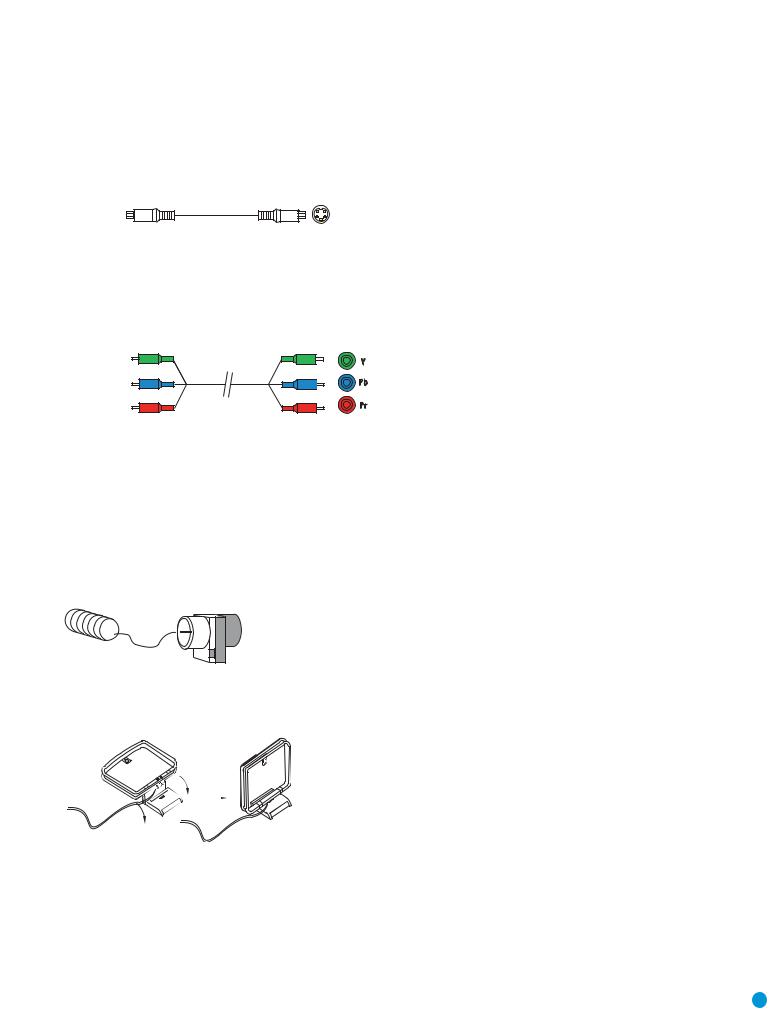
CONNECTIONS
S-video, or “separate” video, transmits the chrominance and luminance components using separate wires contained within a single cable. The plug on an S-video cable contains four metal pins, plus a plastic guide pin. Be careful to line up the plug correctly when you insert it into the jack on the receiver, source or video display.
Composite video cable
Figure 10 – S-Video
Component video separates the video signal into three components – one luminance (“Y”) and two subsampled color signals (“Pb” and “Pr”) – that are transmitted using three separate cables. The “Y” cable is colorcoded green, the “Pb” cable is colored blue and the “Pr” cable is colored red.
Component video cable
Figure 11 – Component Video
If it’s available on your video display, component video is recommended as the best quality connection, followed by S-video and then composite video.
Antennas
The AVR 145 uses separate terminals for the included FM and AM antennas that provide proper reception for the tuner.
The FM antenna uses a 75-ohm F-connector.
Figure 12 – FM Antenna
The AM loop antenna needs to be assembled. Then connect the two leads to the screw terminals on the receiver.
Figure 13 – AM Antenna
RS-232 Serial Port
The RS-232 serial port on the AVR 145 is used only for data. If Harman Kardon releases a software upgrade for the receiver’s operating system at some time in the future, the upgrade may be downloaded
to the AVR using this port. Complete instructions will be provided at that time.
17
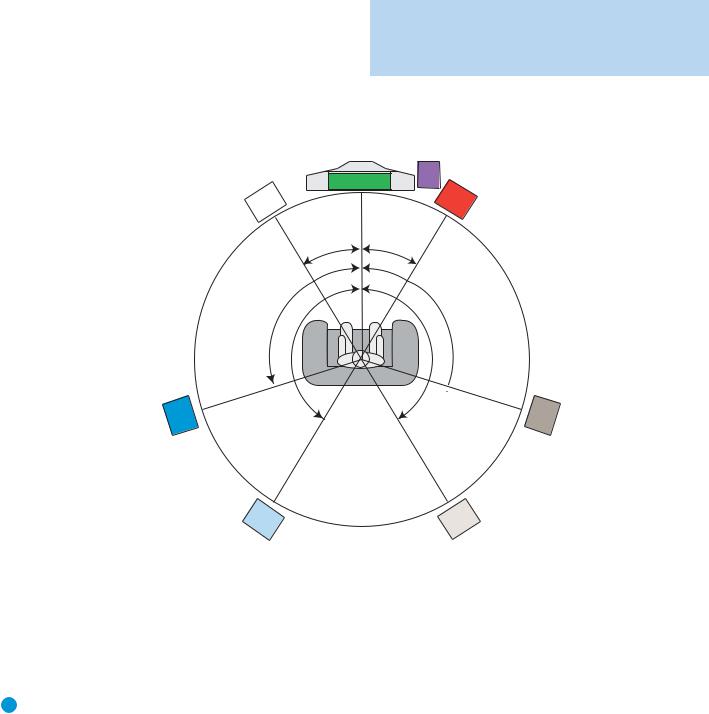
SPEAKER PLACEMENT
Before you begin to connect cables, it is important to set up your speakers in their correct locations in the room.
Optimally, the speakers should be placed in a circle with the listening position at its center. The distance from the listening position to the video display forms the radius of the circle.
The speakers should be angled so that they directly face the listening position.
The center speaker is placed either on top of, below or mounted on the wall above or below the video display screen.
The front left and right speakers are placed along the circle, about 30 degrees from the center speaker and angled toward the listener.
It is best to place the front left/right and center speakers as close to the same height as possible, preferably at about the same height as the listener’s ears. In any event the center speaker should be no more than two feet above or below the left/right speakers.
The side surround speakers should be placed 110 degrees from the center speaker, that is, slightly behind and angled toward the listener. If this isn’t feasible, place the surround speakers behind the listener, with each surround speaker facing the opposite-side front speaker. The surround speakers may be placed a little higher than the listener’s ears.
The subwoofer’s location is less critical, since low-frequency sounds are omnidirectional. Placing the subwoofer close to a wall or in a corner will reinforce the low frequencies, and may create a “boomy” sound. You may wish to experiment over time by placing the subwoofer where the listener normally sits and then walking around the room until the low frequencies sound best. Place the subwoofer in that spot.
NOTE: Your receiver will sound its best when the same model loudspeaker is used for all positions (other than the subwoofer). If that isn’t possible, try to use speakers made by the same manufacturer.
SUB
C
FL |
FR |
30° |
30° |
110° |
110° |
|
|
150° |
150° |
SL  SR
SR
Alternate Placement |
Alternate Placement |
for Side Surround |
for Side Surround |
Left Speaker |
Right Speaker |
Figure 14 – |
Speaker Placement |
18
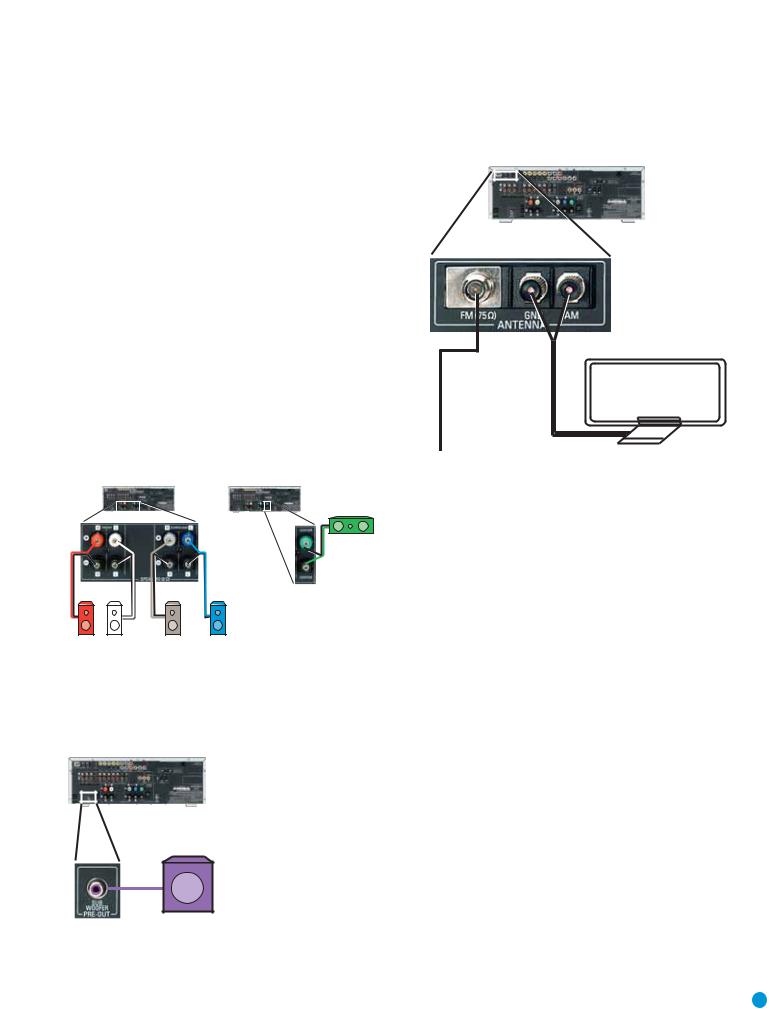
You are now ready to connect your various components to your receiver. Before beginning, make sure that all components, including the AVR 145, are turned completely off and their power cords are unplugged. Don’t plug any of the power cords back in until you have finished making all of your connections.
Remember that your receiver generates heat while it is playing. Select a location that leaves several inches of space on all sides of the receiver. It is preferable to avoid completely enclosing the receiver inside a cabinet. It is also preferable to stack components on separate shelves rather than directly on top of the receiver. Some surface finishes are delicate. Try to select a location with a sturdy surface finish.
Step One – Connect the Speakers
If you have not yet done so, place your speakers in the listening room as described in the Speaker Placement section above.
Connect the center, front left, front right, surround left and surround right loudspeakers to the corresponding speaker terminals on the AVR 145. Remember to maintain the proper polarity by always connecting the positive and negative terminals on each speaker to the positive and negative terminals on the receiver. Use the Connection Color Guide
on page 15 as a reference.
INSTALLATION
Step Three – Connect the Antennas
Connect the FM and AM antennas to their terminals.
AVR 145
AM
FM
Figure 17 – Antenna Connections
AVR 145
AVR 145
C
FR |
FL |
SR |
SL |
Figure 15 – Speaker Connections
Step Two – Connect the Subwoofer
Connect the Subwoofer Output on the AVR 145 to the line-level input on your subwoofer. Consult the manufacturer’s guide for the subwoofer for additional information.
AVR 145
SUB
Figure 16 – Subwoofer Connection
Step Four – Connect the Source Components
Use the worksheets in the Appendix to note which connections you will use for each of your source devices.
For each source, select a source input (Video 1, Video 2, Video 3, etc.). In Table 2 we recommend connecting certain types of sources to certain source inputs to make it easier to program and use the remote control.
Decide which audio connections you will use. If your source device has them, use either the coaxial digital or the optical digital audio connection. Referring to Table 2, we recommend you connect the DVD source to the Coaxial 1 input jack, and the source designated Video 2 to the Optical 2 input jack. However, you may make whatever connections are best for your system.
In addition to the digital audio connections, we recommend that you connect the analog audio connections for each source, as a backup to the digital connections. For sources that don’t have digital audio outputs, you must use the analog audio connections.
For each video source, select one type of video connection. Component video is preferred, but both your source device and your video display must have this type of video capability. If either device does not, then use S-video. Again, if either your source device or your video display doesn’t have S-video connections, then use composite video.
Referring to Table 2, we recommend that you connect the DVD source to the Component Video 1 inputs, and any one source designated as Video 1, Video 2 or Video 3 to the Component Video 2 inputs. However, you may make whatever video connections are best for your system.
19
